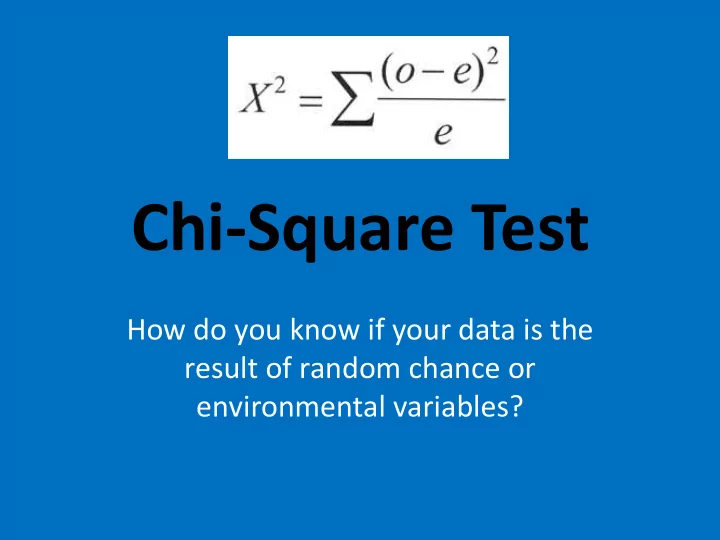

Chi-Square Test How do you know if your data is the result of random chance or environmental variables?
Chi-Square Test • Used to compare categorical data and evaluate if differences between the data sets are statistically significant or due to chance In other words… • Is the variation between observed and expected data due to chance or due to other factors (variables)?
Chi-square Sum Observed values Expected values
Null Hypothesis (H 0 ) • States that there is no statistical significant difference between the observed and expected frequencies • In statistics, a “ significant ” difference means there is a less than 5% chance that the variation in the data is due to random/chance events • Goal of an experiment is to invalidate (or “nullify”) the null hypothesis
Effect of Fertilizer on Plant Growth Null Hypothesis (H 0 ) Alternative Hypothesis (H 1 ) The application of The application of fertilizer fertilizer does not affect affects plant growth. plant growth.
Effect of Humidity on Isopod Behavior Null Hypothesis (H 0 ) Alternative Hypothesis (H 1 )
Effect of Humidity on Isopod Behavior Expected Values? Observed Values?
Application of the Chi-Square Test • Used to either fail to reject or reject the null hypothesis • Fail to reject? The variation in the data is due to chance (bad data!) • Reject? The variation in the data is due to some variable in the experiment (good data!)
Is the difference between observed and expected values due to chance or a variable? • B (brown) • b (white) • 100 plants • Expect? • Observed = 57 brown, 43 white
How to Use the Chi-Square Test • 1 st – Specify the null hypothesis • 2 nd – Determine the degrees of freedom (n-1) (number of possible outcomes – 1) • 3 rd – Determine the critical value using Chi- Square Distribution Table (p = 0.05, or 95% sure) • 4 th – Calculate Chi-Square • 5 th – Compare Chi-Square value with the critical value
Degrees of Freedom
Degrees of Freedom
Determine Critical Value • Is your chi-square value in the RED zone ? Then you CANNOT claim that the variation in the data observed is due to the variable you are testing Not Significant Significant
Chi-Square Value? • If the chi-squared value exceeds (or is greater than) the critical value, then you reject the null hypothesis. This means that the variation in the data is due to a variable being tested ( “statistically significant” ). • If the chi-squared value is less than the critical value, then you fail to reject the null hypothesis. This means that the variation in the data is due to chance.
Calculate Chi-Square for Activity A2
Recommend
More recommend